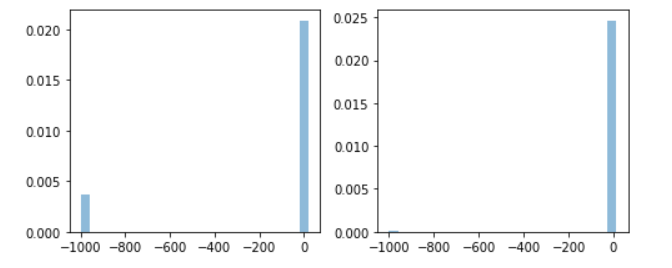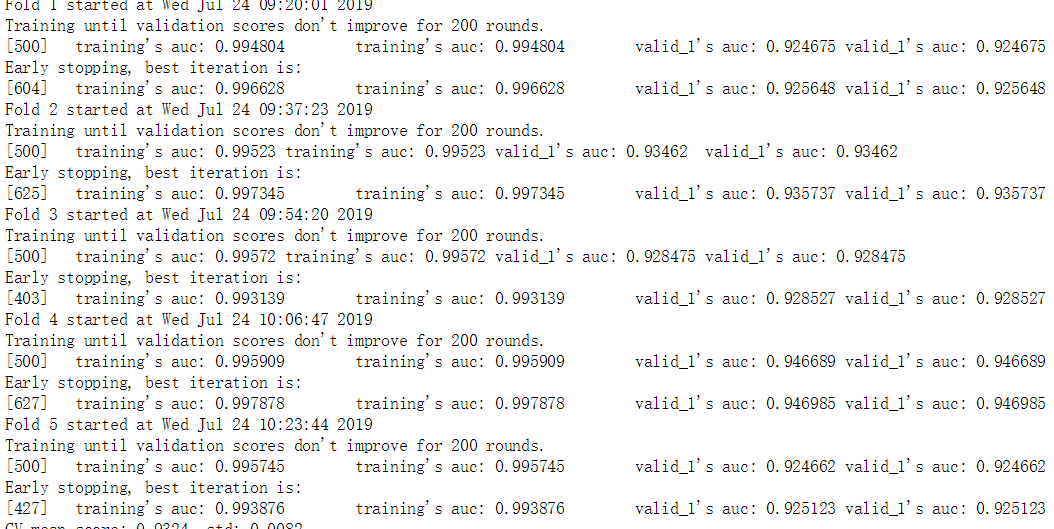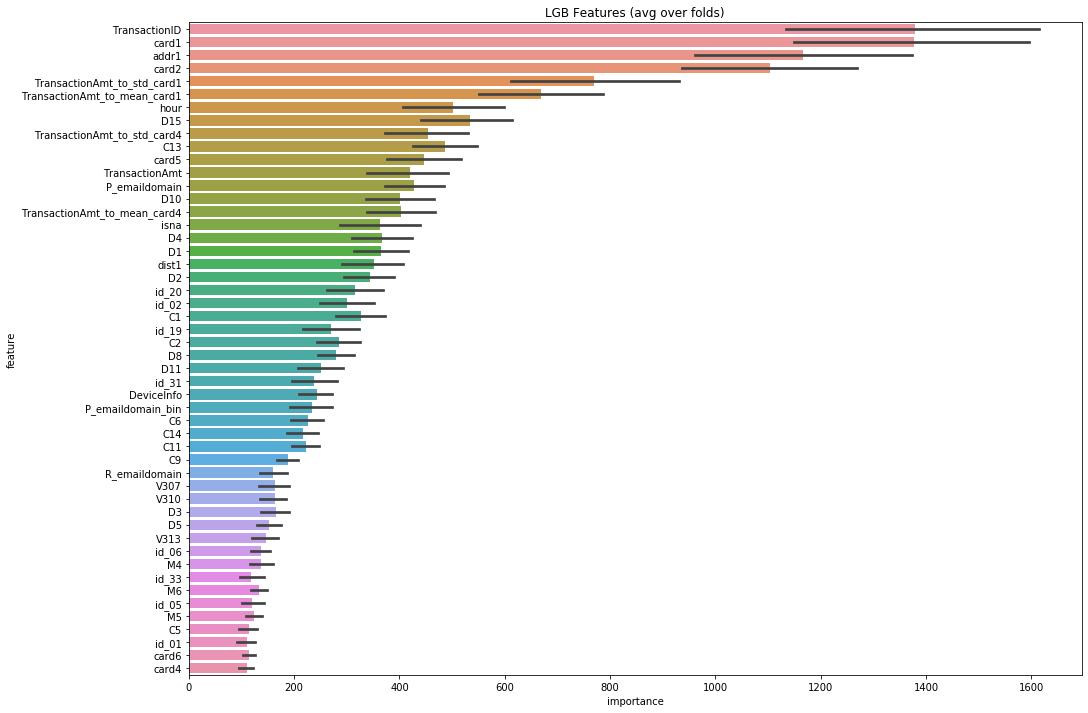Record the details of a kaggle-based game, time series segmentation, feature construction, missing value processing.
Preface
This time, I participated in a credit card fraud prediction project on kaggle. I hope some details of the competition can be recorded and shared in order to avoid long forgetting.
Competition Address: https://www.kaggle.com/c/ieee-fraud-detection
data processing
Briefly describe the data characteristics of this competition:
1. 400 anonymous features
2. Some features have large-scale missing values.
3. Distribution of missing values in training and prediction data is quite different.
4. Characteristics of suspected time increment (to confirm)
5. Two kinds of anonymous data are given, one is about the card account information, the other is the card transaction information.
// An highlighted block #Read data train_id=pd.read_csv('data1/train_identity.csv') test_id=pd.read_csv('data1/test_identity.csv') train_data=pd.read_csv('data1/train_transaction.csv') test_data=pd.read_csv('data1/test_transaction.csv') #Combine the two types of data and clear the memory at the same time train = train_data.merge(train_id, how='left', on='TransactionID') test = test_data.merge(test_id, how='left',on='TransactionID') del train_id; gc.collect() del test_id; gc.collect() del train_data; gc.collect() del test_data; gc.collect() train.describe() train.isnull().sum()

TransactionID 0
isFraud 0
TransactionDT 0
TransactionAmt 0
ProductCD 0
card1 0
card2 8933
card3 1565
card4 1577
card5 4259
card6 1571
addr1 65706
addr2 65706
dist1 352271
dist2 552913
P_emaildomain 94456
R_emaildomain 453249
C1 0
C2 0
C3 0
C4 0
C5 0
C6 0
C7 0
C8 0
C9 0
C10 0
C11 0
C12 0
C13 0
...
id_11 449562
id_12 446307
id_13 463220
id_14 510496
id_15 449555
id_16 461200
id_17 451171
id_18 545427
id_19 451222
id_20 451279
id_21 585381
id_22 585371
id_23 585371
id_24 585793
id_25 585408
id_26 585377
id_27 585371
id_28 449562
id_29 449562
id_30 512975
id_31 450258
id_32 512954
id_33 517251
id_34 512735
id_35 449555
id_36 449555
id_37 449555
id_38 449555
DeviceType 449730
DeviceInfo 471874
Length: 434, dtype: int64
Comparison of missing values between train and test:
training_missing = train.isna().sum(axis=0) / train.shape[0] test_missing = test.isna().sum(axis=0) / test.shape[0] change = (training_missing / test_missing).sort_values(ascending=False) change = change[change<1e6] # remove the divide by zero errors train_more=change[change>4].reset_index() train_more.columns=['train_more_id','rate'] test_more=change[change<0.4].reset_index() test_more.columns=['test_more_id','rate'] train_more_id=train_more['train_more_id'].values train[train_more_id].head()

In comparison with V80, the missing values are filled in with -999. It is obvious that the number of train s missing after ["Transaction DT"]>2.5e7 is much higher than that of Test.
fig, axs = plt.subplots(ncols=2)
train_vals = train["V80"].fillna(-999)
test_vals = test[test["TransactionDT"]>2.5e7]["V80"].fillna(-999) # values following the shift
axs[0].hist(train_vals, alpha=0.5, normed=True, bins=25)
axs[1].hist(test_vals, alpha=0.5, normed=True, bins=25)
fig.set_size_inches(7,3)
plt.tight_layout()

Next, we make a simple analysis of the data.
-
Firstly, it can be observed in the data that most of the fraudulent users use'P_email domain'. Consider listing as a feature separately, and classify all kinds of mailboxes at the same time.
-
As mentioned earlier, Transaction DT is suspected of time increment. The maximum and minimum values of training and prediction set are subtracted, and 364 is obtained by removing'606024', while the training set is 182 and the prediction set is 182.
-
Obviously, the whole data is clean sequential cutting, that is, there is no duplicate time, so if we use datetime to deal with Transaction DT, only hour and weekend can help model training, other features such as MONTH in training may help you get good scores. However, the lack of prediction affects the accuracy of the model. ;
-
In this case, TimeSeries Split segmentation training and testing are used in the training model, which should be the key point of the game.
-
As mentioned earlier, the training and prediction sets are unevenly distributed when Transaction DT is greater than or equal to 2.5e7, which is also the key to get a good ranking.
-
The distribution of hour and isFraud is observed, showing a feature that is significantly higher from 1 to 6 points than other time points, and constructing'night'feature (considering the data based on one year, it is not helpful for feature extraction of seasons and holidays);
-
At the same time, for a user, the number of features missing is also related to the impact of isFraud (the more anonymous, the safer?). Add'isna'feature;
-
Data distribution and its imbalance have been attempted under-sampling and re-sampling as well as smote re-sampling, and the effect is relatively general. Especially under-sampling is lower than I expected, but the last choice is 1:5 under-sampling (after all, fast running, haha) plus classification penalty weight. The reason for adding weight is to classify more 0 into 1 after under-sampling.
Codeisna = train.isna().sum(axis=1)
isna_test = test.isna().sum(axis=1)
train['isna']=train.isna().sum(axis=1)
test['isna']=test.isna().sum(axis=1)import datetime START_DATE = '2017-12-01' startdate = datetime.datetime.strptime(START_DATE, '%Y-%m-%d') train['TransactionDT'] = train['TransactionDT'].apply(lambda x: (startdate + datetime.timedelta(seconds = x))) test['TransactionDT'] = test['TransactionDT'].apply(lambda x: (startdate + datetime.timedelta(seconds = x))) train['hour'] = train['TransactionDT'].dt.hour test['hour'] = test['TransactionDT'].dt.hour train['month'] = train['TransactionDT'].dt.month test['month'] = test['TransactionDT'].dt.month #print(train['TransactionDT']) x=test['hour']<7 x1=test['hour']>19 x.astype(int) x1.astype(int) x2=np.add(x,x1) x2.astype(int) test['night']=x2.astype(int) x=train['hour']<7 x1=train['hour']>19 x.astype(int) x1.astype(int) x2=np.add(x,x1) x2.astype(int) train['night']=x2.astype(int) index _pro=train['P_emaildomain']=='protonmail.com' index_pro_data=train['P_emaildomain'][index_pro] train['isprotonmail']=index_pro_data del index_pro del index_pro_data index_pro=test['P_emaildomain']=='protonmail.com' index_pro_data=test['P_emaildomain'][index_pro] test['isprotonmail']=index_pro_data del index_pro del index_pro_data train.loc[ (train.isprotonmail.isnull()), 'isprotonmail' ] = 0 train['isprotonmail'].describe(include="all") test.loc[ (test.isprotonmail.isnull()), 'isprotonmail' ] = 0 test['isprotonmail'].describe(include="all") emails = {'gmail': 'google', 'att.net': 'att', 'twc.com': 'spectrum', 'scranton.edu': 'other', 'optonline.net': 'other', 'hotmail.co.uk': 'microsoft', 'comcast.net': 'other', 'yahoo.com.mx': 'yahoo', 'yahoo.fr': 'yahoo', 'yahoo.es': 'yahoo', 'charter.net': 'spectrum', 'live.com': 'microsoft', 'aim.com': 'aol', 'hotmail.de': 'microsoft', 'centurylink.net': 'centurylink', 'gmail.com': 'google', 'me.com': 'apple', 'earthlink.net': 'other', 'gmx.de': 'other', 'web.de': 'other', 'cfl.rr.com': 'other', 'hotmail.com': 'microsoft', 'protonmail.com': 'other', 'hotmail.fr': 'microsoft', 'windstream.net': 'other', 'outlook.es': 'microsoft', 'yahoo.co.jp': 'yahoo', 'yahoo.de': 'yahoo', 'servicios-ta.com': 'other', 'netzero.net': 'other', 'suddenlink.net': 'other', 'roadrunner.com': 'other', 'sc.rr.com': 'other', 'live.fr': 'microsoft', 'verizon.net': 'yahoo', 'msn.com': 'microsoft', 'q.com': 'centurylink', 'prodigy.net.mx': 'att', 'frontier.com': 'yahoo', 'anonymous.com': 'other', 'rocketmail.com': 'yahoo', 'sbcglobal.net': 'att', 'frontiernet.net': 'yahoo', 'ymail.com': 'yahoo', 'outlook.com': 'microsoft', 'mail.com': 'other', 'bellsouth.net': 'other', 'embarqmail.com': 'centurylink', 'cableone.net': 'other', 'hotmail.es': 'microsoft', 'mac.com': 'apple', 'yahoo.co.uk': 'yahoo', 'netzero.com': 'other', 'yahoo.com': 'yahoo', 'live.com.mx': 'microsoft', 'ptd.net': 'other', 'cox.net': 'other', 'aol.com': 'aol', 'juno.com': 'other', 'icloud.com': 'apple'} us_emails = ['gmail', 'net', 'edu'] for c in ['P_emaildomain', 'R_emaildomain']: train[c + '_bin'] = train[c].map(emails) test[c + '_bin'] = test[c].map(emails) train[c + '_suffix'] = train[c].map(lambda x: str(x).split('.')[-1]) test[c + '_suffix'] = test[c].map(lambda x: str(x).split('.')[-1]) train[c + '_suffix'] = train[c + '_suffix'].map(lambda x: x if str(x) not in us_emails else 'us') test[c + '_suffix'] = test[c + '_suffix'].map(lambda x: x if str(x) not in us_emails else 'us') from sklearn.preprocessing import Imputer imp = Imputer(missing_values='NaN', strategy='most_frequent', axis=0)
Treatment of missing values
test[['dist1','dist2','C1','C2','C4','C5','C6','C7','C8','C9','C10','C11','C12','C13','C14']]=imp.fit_transform(test[['dist1','dist2','C1','C2','C4','C5','C6','C7','C8','C9','C10','C11','C12','C13','C14']]) train[['dist1','dist2','C1','C2','C4','C5','C6','C7','C8','C9','C10','C11','C12','C13','C14']]=imp.fit_transform(train[['dist1','dist2','C1','C2','C4','C5','C6','C7','C8','C9','C10','C11','C12','C13','C14']]) test[test.TransactionDT>2.5e7][train_more_id]=imp.fit_transform(test[test.TransactionDT>2.5e7][train_more_id]) train[train_more_id]=imp.fit_transform(train[train_more_id])
This part deals with a few missing data, and then some missing but important features are filled with random forest method. Here is only a piece of code.
from sklearn.ensemble import RandomForestRegressor
def set_missing_card2(df):
# Remove existing numerical features and throw them into Random Forest Regressor
give_df = df[['card2', 'TransactionID', 'card1', 'TransactionAmt', 'C1', 'C2', 'C4', 'C5', 'C6', 'C7', 'C8', 'C9', 'C10', 'C11', 'C12', 'C13']]
# Passengers are divided into known age and unknown age.
# ,'card3','card5','addr1''addr2'
known_card2 = give_df[give_df.card2.notnull()].as_matrix()
unknown_card2 = give_df[give_df.card2.isnull()].as_matrix()
# y is the target age
y = known_card2[:, 0]
# X is the characteristic attribute value
X = known_card2[:, 1:]
# fit into Random Forest Regressor
rfr = RandomForestRegressor(random_state=0, n_estimators=10, n_jobs=-1)
rfr.fit(X, y)
# Prediction of unknown age results using the obtained model
predictedcard2= rfr.predict(unknown_card2[:, 1::])# One or two colons are the same.
# Filling in the missing data with the predicted results
df.loc[(df.card2.isnull()), 'card2']= predictedcard2
return df, rfr
# train_data.head()
train, rfr = set_missing_card2(train)
test, rfr = set_missing_card2(test)
Next, other missing feature values and dictionary character feature codes are processed.
for c1, c2 in train.dtypes.reset_index().values:
if c2=='O':
train[c1] = train[c1].map(lambda x: labels[str(x).lower()])
test[c1] = test[c1].map(lambda x: labels[str(x).lower()])
train.fillna(-999, inplace=True)
test.fillna(-999, inplace=True)
for f in test.columns: #There are items in the train that need to be predicted, so I don't want to remove them and use test directly.
if train[f].dtype=='object' or test[f].dtype=='object':
print(f)
lbl = preprocessing.LabelEncoder()
lbl.fit(list(train[f].values) + list(test[f].values))
train[f] = lbl.transform(list(train[f].values))
test[f] = lbl.transform(list(test[f].values))
The original idea here was to separate the data by month and then do under/resampling. It was done by training for 4 months and testing for 2 months. Later, it was more convenient to directly divide the data into TimeSeries Split.
columns_list=list(train) ####Separating data sets by month train_12=train[train.month==12] train_1=train[train.month==1] train_2=train[train.month==2] train_3=train[train.month==3] train_4=train[train.month==4] train_5=train[train.month==5] train_6=train[train.month==6] from imblearn.under_sampling import RandomUnderSampler ran=RandomUnderSampler(return_indices=True) ##intialize to return indices of dropped rows train_12,y_train12,dropped12 = ran.fit_sample(train_12,train_12['isFraud']) train_1,y_train1,dropped1 = ran.fit_sample(train_1,train_1['isFraud']) train_2,y_train2,dropped2 = ran.fit_sample(train_2,train_2['isFraud']) train_3,y_train3,dropped3 = ran.fit_sample(train_3,train_3['isFraud']) train_4,y_train4,dropped4 = ran.fit_sample(train_4,train_4['isFraud']) train_5,y_train5,dropped5 = ran.fit_sample(train_5,train_5['isFraud']) train_6,y_train6,dropped6 = ran.fit_sample(train_6,train_6['isFraud']) del train del y_train12 del y_train1 del y_train2 del y_train3 del y_train4 del y_train5 del y_train6 '''#Random oversampling from imblearn.over_sampling import RandomOverSampler ros = RandomOverSampler(random_state=0) train_data, y_train = ros.fit_sample(train, y_train) del train; gc.collect()''' '''#smote oversampling from imblearn.over_sampling import SMOTE smote = SMOTE(frac=0.1, random_state=1) train_data, y_train = smote.fit_sample(train, y_train)''' '''from imblearn.under_sampling import RandomUnderSampler ran=RandomUnderSampler(return_indices=True) ##intialize to return indices of dropped rows train_data,y_train,dropped = ran.fit_sample(train,y_train) del train; gc.collect()'''
Model Construction Training Section
This time, we did not use SVM to play the game. We used the artifact XGBOOST. In two days, we will push XGBOOST by hand and post some adjustments. Here we will not go into details. Direct to the code on the document:
def fast_auc(y_true, y_prob):
y_true = np.asarray(y_true)
y_true = y_true[np.argsort(y_prob)]
nfalse = 0
auc = 0
n = len(y_true)
for i in range(n):
y_i = y_true[i]
nfalse += (1 - y_i)
auc += y_i * nfalse
auc /= (nfalse * (n - nfalse))
return auc
def eval_auc(y_true, y_pred):
return 'auc', fast_auc(y_true, y_pred), True
def group_mean_log_mae(y_true, y_pred, types, floor=1e-9):
maes = (y_true-y_pred).abs().groupby(types).mean()
return np.log(maes.map(lambda x: max(x, floor))).mean()
def train_model_classification(X, X_test, y, params, folds, model_type='lgb', eval_metric='auc', columns=None, plot_feature_importance=False, model=None,
verbose=10000, early_stopping_rounds=200, n_estimators=50000, splits=None, n_folds=3, averaging='usual', n_jobs=-1):
"""
A function to train a variety of classification models.
Returns dictionary with oof predictions, test predictions, scores and, if necessary, feature importances.
:params: X - training data, can be pd.DataFrame or np.ndarray (after normalizing)
:params: X_test - test data, can be pd.DataFrame or np.ndarray (after normalizing)
:params: y - target
:params: folds - folds to split data
:params: model_type - type of model to use
:params: eval_metric - metric to use
:params: columns - columns to use. If None - use all columns
:params: plot_feature_importance - whether to plot feature importance of LGB
:params: model - sklearn model, works only for "sklearn" model type
"""
columns = X.columns if columns is None else columns
n_splits = folds.n_splits if splits is None else n_folds
X_test = X_test[columns]
# to set up scoring parameters
metrics_dict = {'auc': {'lgb_metric_name': eval_auc,
'catboost_metric_name': 'AUC',
'sklearn_scoring_function': metrics.roc_auc_score},
}
result_dict = {}
if averaging == 'usual':
# out-of-fold predictions on train data
oof = np.zeros((len(X), 1))
# averaged predictions on train data
prediction = np.zeros((len(X_test), 1))
elif averaging == 'rank':
# out-of-fold predictions on train data
oof = np.zeros((len(X), 1))
# averaged predictions on train data
prediction = np.zeros((len(X_test), 1))
# list of scores on folds
scores = []
feature_importance = pd.DataFrame()
# split and train on folds
for fold_n, (train_index, valid_index) in enumerate(folds.split(X)):
print(f'Fold {fold_n + 1} started at {time.ctime()}')
if type(X) == np.ndarray:
X_train, X_valid = X[columns][train_index], X[columns][valid_index]
y_train, y_valid = y[train_index], y[valid_index]
else:
X_train, X_valid = X[columns].iloc[train_index], X[columns].iloc[valid_index]
y_train, y_valid = y.iloc[train_index], y.iloc[valid_index]
if model_type == 'lgb':
model = lgb.LGBMClassifier(**params, n_estimators=n_estimators, n_jobs = n_jobs)
model.fit(X_train, y_train,
eval_set=[(X_train, y_train), (X_valid, y_valid)], eval_metric=metrics_dict[eval_metric]['lgb_metric_name'],
verbose=verbose, early_stopping_rounds=early_stopping_rounds)
y_pred_valid = model.predict_proba(X_valid)[:, 1]
y_pred = model.predict_proba(X_test, num_iteration=model.best_iteration_)[:, 1]
if model_type == 'xgb':
train_data = xgb.DMatrix(data=X_train, label=y_train, feature_names=X.columns)
valid_data = xgb.DMatrix(data=X_valid, label=y_valid, feature_names=X.columns)
watchlist = [(train_data, 'train'), (valid_data, 'valid_data')]
model = xgb.train(dtrain=train_data, num_boost_round=n_estimators, evals=watchlist, early_stopping_rounds=early_stopping_rounds, verbose_eval=verbose, params=params)
y_pred_valid = model.predict(xgb.DMatrix(X_valid, feature_names=X.columns), ntree_limit=model.best_ntree_limit)
y_pred = model.predict(xgb.DMatrix(X_test, feature_names=X.columns), ntree_limit=model.best_ntree_limit)
if model_type == 'sklearn':
model = model
model.fit(X_train, y_train)
y_pred_valid = model.predict(X_valid).reshape(-1,)
score = metrics_dict[eval_metric]['sklearn_scoring_function'](y_valid, y_pred_valid)
print(f'Fold {fold_n}. {eval_metric}: {score:.4f}.')
print('')
y_pred = model.predict_proba(X_test)
if model_type == 'cat':
model = CatBoostClassifier(iterations=n_estimators, eval_metric=metrics_dict[eval_metric]['catboost_metric_name'], **params,
loss_function=metrics_dict[eval_metric]['catboost_metric_name'])
model.fit(X_train, y_train, eval_set=(X_valid, y_valid), cat_features=[], use_best_model=True, verbose=False)
y_pred_valid = model.predict(X_valid)
y_pred = model.predict(X_test)
if averaging == 'usual':
oof[valid_index] = y_pred_valid.reshape(-1, 1)
scores.append(metrics_dict[eval_metric]['sklearn_scoring_function'](y_valid, y_pred_valid))
prediction += y_pred.reshape(-1, 1)
elif averaging == 'rank':
oof[valid_index] = y_pred_valid.reshape(-1, 1)
scores.append(metrics_dict[eval_metric]['sklearn_scoring_function'](y_valid, y_pred_valid))
prediction += pd.Series(y_pred).rank().values.reshape(-1, 1)
if model_type == 'lgb' and plot_feature_importance:
# feature importance
fold_importance = pd.DataFrame()
fold_importance["feature"] = columns
fold_importance["importance"] = model.feature_importances_
fold_importance["fold"] = fold_n + 1
feature_importance = pd.concat([feature_importance, fold_importance], axis=0)
prediction /= n_splits
print('CV mean score: {0:.4f}, std: {1:.4f}.'.format(np.mean(scores), np.std(scores)))
result_dict['oof'] = oof
result_dict['prediction'] = prediction
result_dict['scores'] = scores
if model_type == 'lgb':
if plot_feature_importance:
feature_importance["importance"] /= n_splits
cols = feature_importance[["feature", "importance"]].groupby("feature").mean().sort_values(
by="importance", ascending=False)[:50].index
best_features = feature_importance.loc[feature_importance.feature.isin(cols)]
plt.figure(figsize=(16, 12));
sns.barplot(x="importance", y="feature", data=best_features.sort_values(by="importance", ascending=False));
plt.title('LGB Features (avg over folds)');
result_dict['feature_importance'] = feature_importance
result_dict['top_columns'] = cols
return result_dict
model parameter
It's used here. TimeSeriesSplit Divide.
from sklearn.model_selection import TimeSeriesSplit
n_fold = 7
folds = TimeSeriesSplit(n_splits=n_fold)
folds = KFold(n_splits=5)
import time
params = {'num_leaves': 256,
'min_child_samples': 79,
'objective': 'binary',
'max_depth': 13,
'learning_rate': 0.03,
"boosting_type": "gbdt",
"subsample_freq": 3,
"subsample": 0.9,
"bagging_seed": 11,
"metric": 'auc',
"verbosity": -1,
'reg_alpha': 0.3,
'reg_lambda': 0.3,
'colsample_bytree': 0.9,
# 'categorical_feature': cat_cols
}
result_dict_lgb = train_model_classification(X=train, X_test=X_test, y=y_train, params=params, folds=folds, model_type='lgb', eval_metric='auc', plot_feature_importance=True,
verbose=500, early_stopping_rounds=200, n_estimators=5000, averaging='usual', n_jobs=-1)
* Training Result and Characteristic Importance Ranking

At the time of final submission, give me a surprise of 0.9430, a little wonder why the score is higher than the local training accuracy? Are some features not helpful in local training but effective in predicting? For the time being, if I drop 10%, I'm thinking about stacking several models (this method is hardly useful in production, but it's a big killer in competition, but I still hope to find more features and get better scores with the way out).